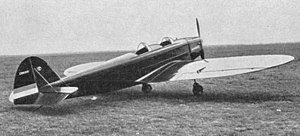Rogožarski SIM-VI
| Rogožarski SIM-VI | |
|---|---|

| |
| Trainer aircraft Rogožarski SIM VIa | |
| Role | Trainer (aircraft)
|
| National origin | Yugoslav |
| Manufacturer | Prva Srpska Fabrika Aeroplana Živojin Rogožarski, Belgrade |
| Designer | Sima Milutinović |
| First flight | 1937 |
| Retired | 1941 |
| Status | inactive |
| Primary user | Yugoslav Aero Club |
| Number built | 2[1] |
The Rogožarski SIM-VI (
Design and development


The SIM-VI was designed by engineer
Variants
- Rogozarski SIM-VI – with 37 kW Walter Mikron engine
- Rogozarski SIM-VI-a – with 44 kW Walter Mikron II engine
Immediately after completing the flight tests of aircraft SIM-VI, engineer Milutinovic undertook the repair of the shortcomings he had observed, so that by the end of the 1937 Rogozarski had a new variant of this airplane which was designated SIM-VI-a. It had a more powerful engine Walter Mikron II 44 kW (60 hp). An increase in engine power required strengthening of the basic structure which Milutinovic used to make general improvements to the aircraft. Wing relative thickness was increased from 6% to 15% which strengthened the wings, and resulting in the removal of wire ties. Now the wings were covered with cardboard to the half swing instead of cloth which resulted in an improved overall stiffness of the aircraft. This also enabled the landing gear and aerodynamic characteristics of new aircraft to be upgraded, while the weight was only slightly increased.
Operational history
After successful testing and registration (YU-PDX)[4] the SIM-VI was bought by the Central Administration of the Aero Club, which used the it at airshows and for the training of sport pilots. The aircraft did not enter serial production because it could not be used at smaller and under-equipped airports that existed in central Serbia.
Flight tests that were carried out at the
Operators
- Aero Club 2 aircraft
- Yugoslav Royal Air Force– One aircraft was impressed into military service in April 1940.
Specifications
General characteristics
- Crew: 2
- Length: 7.05 m (23 ft 2 in)
- Wingspan: 9.50 m (31 ft 2 in)
- Wing area: 15.00 m2 (161.5 sq ft)
- Empty weight: 300 kg (661 lb)
- Gross weight: 500 kg (1,102 lb)
- Powerplant: 1 × Walter Mikron, 4-cylinder in-line piston engine, 37 kW (50 hp)
- Propellers: 2-bladed
Performance
- Maximum speed: 120 km/h (75 mph, 65 kn) 150 km/h (93 mph) at sea level
- Cruise speed: 60 km/h (37 mph, 32 kn)
- Range: 450 km (280 mi, 240 nmi)
- Service ceiling: 4,000 m (13,000 ft)
See also
Notes
- ^ Петровић, O. (2004). Војни аероплани Краљевине СХС/Југославије (Део II: 1931–1941.). Београд: МВЈ Лет 3.
- ISBN 978-86-913973-2-6.
- ^ Станојевић, Драгољуб.; Чедомир Јанић (12/1982.). "Животни пут и дело једног великана нашег ваздухопловства – светао пример и узор нараштајима". Машинство 31: стр. 1870–1871.
- ^ "Golden Years of Aviation - Main". Archived from the original on 2012-02-19. Retrieved 2012-05-30.
- ^ "Golden Years of Aviation - Main". Archived from the original on 2012-02-19. Retrieved 2012-05-30.
References
- Janić, Čedomir; O. Petrović (2011). Short History of Aviation in Serbia. Beograd: Aerokomunikacije. ISBN 978-86-913973-2-6.
- Д. Лучић: Основи практичне аеродинамике са описима аероплана, Библиотека „Ваздухопловног Гласника“, Нови Сад, 1936,
- О. Петровић., Војни аероплани Краљевине СХС/Југославије (Део II: 1931–1941.), Лет 3/2004. Београд, 2004.
- Станојевић, Драгољуб.; Чедомир Јанић (12/1982.). "Животни пут и дело једног великана нашег ваздухопловства – светао пример и узор нараштајима". Машинство 31: стр. 1870–1871.
- Gunston, Bill (1989). World Encyclopaedia of Aero Engines (2 ed.). Wellingborough: Patrick Stephens Ltd. ISBN 1-85260-163-9.
